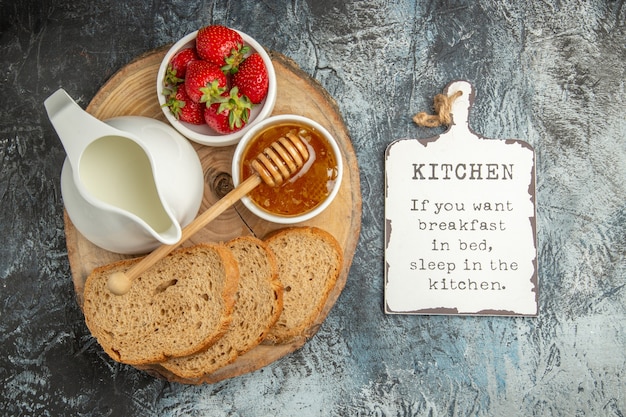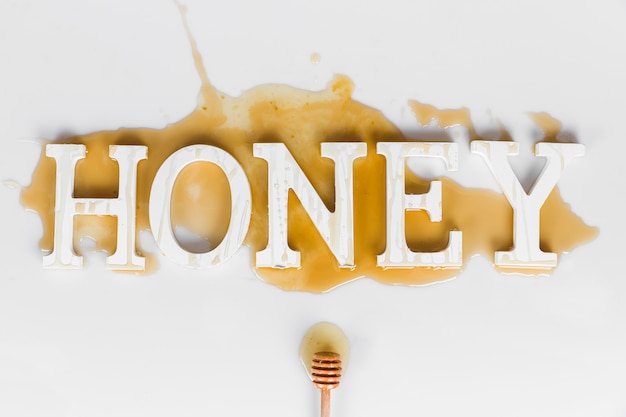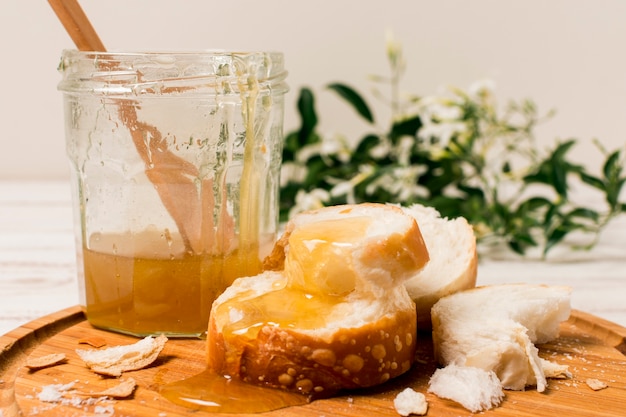Let's be honest, honey isn't just for drizzling on your morning toast, though it's undeniably delicious that way. As someone who's spent years exploring the depths of the culinary world, I've discovered that honey is like a secret ingredient, a culinary chameleon that can transform a dish from ordinary to extraordinary. Its sweetness is undeniable, but its versatility extends far beyond that, adding depth, complexity, and a touch of magic to everything it graces.
So, let's embark on a journey into the world of honey in cooking. I'll share my personal experiences, the tips and tricks I've picked up along the way, and some delectable recipes that'll have you saying, "Honey, you're a star!"
(Part 1) Honey: The Sweetness of Versatility

Honey: More than just a sweetener
Think of honey as a secret weapon in your culinary arsenal. It's sweet, yes, but its magic goes far beyond simple sweetness. Honey possesses this remarkable ability to amplify and enhance other flavors. It can elevate the richness of chocolate, tame the tanginess of lemon, and even add a warm, comforting hug to savory dishes.
My Honey Journey: A Personal Tale
I remember when I first started exploring the world of honey in cooking. I was a tad hesitant, to be honest. I mean, it's sticky! But, I started small, just a sprinkle here, a drizzle there. I used it in glazes for roasted chicken, drizzled it over baked pears, and even added a spoonful to my morning porridge. With each use, I discovered something new, a new flavor combination, a new texture. It was truly addictive! And that's how my love affair with honey began.
The Honey Spectrum: A World of Flavors
Now, before we get into the nitty-gritty, let's talk about the different types of honey. There's a whole world of honey out there, each variety offering a unique flavor profile and a distinct character that can completely transform a dish.
Imagine this: Light honey, like acacia or clover honey, is like a gentle whisper, subtly sweet and delicate. Dark honey, like buckwheat or wildflower honey, is more like a bold statement, full of complex flavors, hints of caramel, and a touch of depth that lingers on your palate.
Choosing the Right Honey: A Culinary Matchmaker
The key, my friend, is to choose the right honey for the right dish. For example, I prefer to use a light honey in my baking because its delicate sweetness doesn't overpower the other flavors. But for a glaze for roasted meats, I opt for a darker honey, its bolder flavor and caramelizing properties adding a touch of richness and complexity.
(Part 2) Cooking with Honey: From Baking to Sauces

Sweet Treats with Honey: A Symphony of Flavors
Honey is a natural sweetener and a beloved ingredient in countless baking recipes. It imparts a lovely golden hue and a subtle, complex sweetness that simply can't be replicated with granulated sugar.
Honey Cake: A Classic with a Twist
One of my all-time favorite honey recipes is a simple honey cake. The honey adds moisture, a beautiful golden color, and a subtle caramel flavor that complements the spices beautifully. I love how the honey makes the cake feel dense and rich, a truly satisfying treat.
Honey Glazed Muffins: A Quick and Delicious Treat
Another favorite is honey-glazed muffins. They're perfect for a quick breakfast or a delightful afternoon snack. I love the way the honey glaze adds a touch of sweetness and a beautiful sheen. Just a little drizzle of honey makes these muffins irresistible.
Savory Dishes with Honey: A Culinary Surprise
Now, don't be afraid to venture beyond the sweet side! Honey can be just as magical in savory dishes.
Honey Glazed Salmon: A Taste of Elegance
My go-to recipe is honey-glazed salmon. It's simple, elegant, and absolutely delicious. The honey adds a touch of sweetness and a beautiful glaze that caramelizes in the oven. The combination of the honey's sweetness with the salmon's richness is truly divine.
Honey Mustard Dressing: A Flavorful Twist
Another favorite is honey mustard dressing. It's perfect for salads, sandwiches, or even as a marinade for chicken. The honey adds a touch of sweetness that perfectly balances the tanginess of the mustard.
Honey in Sauces: A Culinary Masterpiece
Honey is a natural thickener, making it a perfect ingredient for sauces. It can be added to a variety of sauces, from sweet and savory to spicy and tangy. Honey helps create a smooth, glossy texture and adds a touch of sweetness and complexity that elevates any sauce.
Honey-Soy Glaze: A Flavorful Fusion
For example, honey is a key ingredient in a delicious honey-soy glaze. This glaze is perfect for chicken, pork, and even tofu. The honey adds a touch of sweetness that balances the saltiness of the soy sauce, creating a harmonious flavor profile.
Honey-Ginger Sauce: A Spicy Delight
Another popular honey sauce is honey-ginger sauce. This sauce is perfect for stir-fries, dumplings, and even as a dipping sauce for spring rolls. The ginger adds a spicy kick, while the honey adds a touch of sweetness, balancing the flavors beautifully.
(Part 3) Cooking with Honey: Tips and Tricks

Honey: A Balancing Act
Now, let's get down to the nitty-gritty. Honey can be a bit tricky to work with at times. It's sticky, it can crystallize, and it can burn easily. But don't worry, with a few tricks up your sleeve, you can master the art of cooking with honey.
Honey's Sweetness: A Matter of Taste
One thing to keep in mind is that honey's sweetness can vary depending on the type and the nectar source. So, when using honey as a sweetener, it's always a good idea to start with a smaller amount and adjust to taste.
Honey's Texture: A Little Warmth Goes a Long Way
Honey has a thick, syrupy texture, which can make it a bit challenging to incorporate into some recipes. Here's a little trick I use: I like to warm honey gently in the microwave or over a double boiler before using it in recipes. This helps to make it more fluid and easier to mix.
Honey and Heat: A Delicate Dance
Honey is very sensitive to heat. It can caramelize and burn quickly if it's overheated. When cooking with honey, it's always a good idea to use a lower heat and to watch it closely. If you see the honey starting to bubble and turn dark, it's time to reduce the heat or remove it from the stove.
(Part 4) Honey in the Baking World
Honey: Baking's Sweet Secret
Honey is a natural sweetener that can add a unique flavor to your baked goods. It also adds moisture and creates a beautiful golden hue.
Honey Cakes and Muffins: A Touch of Sweetness
I love using honey in cakes and muffins. It adds a subtle, complex sweetness and a lovely golden color. I've even used it to make a delicious honey cake, a real crowd-pleaser.
Honey Cookies: A Chewy Delight
Honey is also great for cookies. It adds a subtle sweetness and a bit of chewiness to the cookies. I've even used it to make a batch of gingerbread cookies, perfect for the holidays.
Honey Glazes: A Finishing Touch
Honey is a natural thickener, so it's a great ingredient for glazes. I use it to make a simple glaze for my cakes and muffins, a real finishing touch.
(Part 5) Honey in Savory Delights
Honey's Savory Side: A culinary adventure
Honey isn't just for sweet treats. It can also add a unique flavor to savory dishes.
Honey-Glazed Chicken: A Flavorful Combination
My go-to honey-based savory recipe is a honey-glazed chicken. It's simple, elegant, and absolutely delicious. The honey adds a touch of sweetness and a beautiful glaze that caramelizes in the oven.
Honey-Mustard Dressing: A Tangy Twist
Honey also works beautifully in a honey-mustard dressing. This dressing is perfect for salads, sandwiches, or even as a marinade for chicken. The honey adds a touch of sweetness that perfectly balances the tanginess of the mustard.
Honey-Ginger Sauce: A Spicy Harmony
Honey-ginger sauce is a versatile sauce that can be used for stir-fries, dumplings, and even as a dipping sauce for spring rolls. The ginger adds a spicy kick, while the honey adds a touch of sweetness, balancing the flavors beautifully.
(Part 6) The Sweet Science of Honey
Honey: A Natural Wonder
Honey is a natural product created by bees from the nectar of flowers. It's a complex mixture of sugars, enzymes, and antioxidants. It's a fascinating ingredient, not just for cooking but also for its health benefits.
Types of Honey: A World of Flavors
There are many different types of honey, each with its own unique flavor and color. Some popular types of honey include:
- Clover Honey: Light, mild, and delicate. It's often used in baking and as a general-purpose sweetener.
- Wildflower Honey: Medium-bodied, with complex flavors that vary depending on the wildflowers that the bees pollinated. It's great for adding a touch of complexity to desserts and savory dishes.
- Buckwheat Honey: Dark, robust, and earthy. It has a unique, almost molasses-like flavor and is often used in savory dishes, glazes, and marinades.
- Manuka Honey: Known for its antibacterial properties. It's often used topically for wound healing and is also a popular choice for boosting immunity.
Honey's Properties: Sweetness and Health Benefits
Honey is a natural sweetener and can be used in a wide variety of recipes. It also has antibacterial and antioxidant properties, making it a healthy choice.
(Part 7) Honey: Storage and Handling
Honey's Shelf Life: A Timeless Ingredient
Honey is a natural preservative and can last for a long time. It's best to store honey in a cool, dark place.
Crystallization: A Natural Process
Honey can crystallize over time, especially if it's stored in a cool place. Crystallization doesn't affect the flavor of honey, but it can make it difficult to use. To liquefy crystallized honey, gently warm the jar in a pan of hot water.
Honey's Sticky Nature: A Few Tips
Honey is sticky, and it can be difficult to remove from containers or utensils. A good trick I've learned is to use a silicone spatula or a damp cloth to clean up any spills.
(Part 8) Honey: FAQs
1. Can I substitute honey for sugar in baking?
Yes, you can substitute honey for sugar in baking, but you'll need to adjust the recipe. Honey is sweeter than sugar, so you'll need to use less. You'll also need to adjust the liquid content in the recipe as honey adds moisture.
2. Does honey burn easily?
Honey is very sensitive to heat and can burn easily. It's best to cook honey over a low heat and to watch it closely.
3. How do I store honey?
Store honey in a cool, dark place. Honey can crystallize over time, but this doesn't affect its flavor.
4. Is honey a healthy sweetener?
Honey is a natural sweetener and has some health benefits. However, it's still high in sugar, so it should be consumed in moderation.
5. What is the best type of honey for baking?
Light honey, like clover or acacia honey, is best for baking because it doesn't overpower the other flavors.
So, there you have it – a comprehensive guide to using honey in your recipes. Remember, honey is a versatile and delicious ingredient that can add a unique flavor to your dishes. Get creative and experiment with honey in your kitchen. You'll be surprised by the results!
Everyone is watching

Prime Rib Roast Cooking Time Chart: Per Pound Guide
Cooking TipsPrime rib roast. Just the name conjures images of lavish dinners, crackling fires, and hearty laughter. It’s ...

How Long to Bake Potatoes in the Oven (Perfect Every Time)
Cooking TipsBaked potatoes are a staple in my kitchen. They're incredibly versatile, delicious, and surprisingly easy to m...

Perfect Rice Every Time: The Ultimate Guide to Cooking Rice
Cooking TipsAs a self-proclaimed foodie, I've always been a bit obsessed with rice. It's the foundation of countless cuisi...

The Ultimate Guide to Cooking Asparagus: Tips, Techniques, and Recipes
Cooking TipsAsparagus. The mere mention of this spring delicacy conjures up images of vibrant green spears, crisp and burs...

Ultimate Guide to Cooking the Perfect Thanksgiving Turkey
Cooking TipsThanksgiving. Just the word conjures up images of overflowing tables laden with delicious food, the scent of r...
